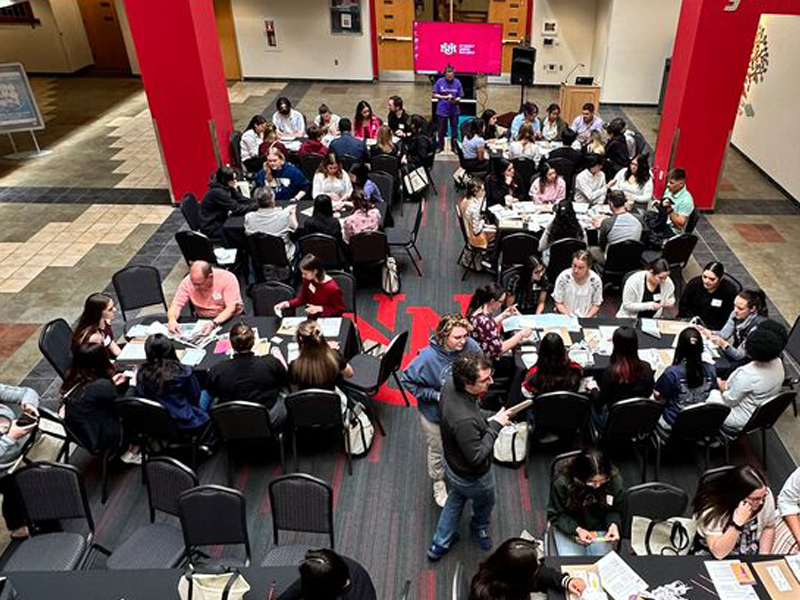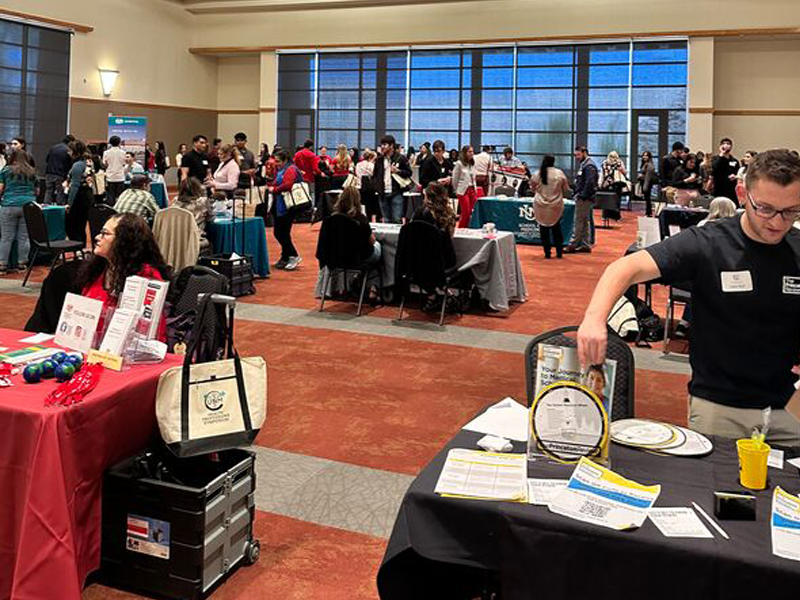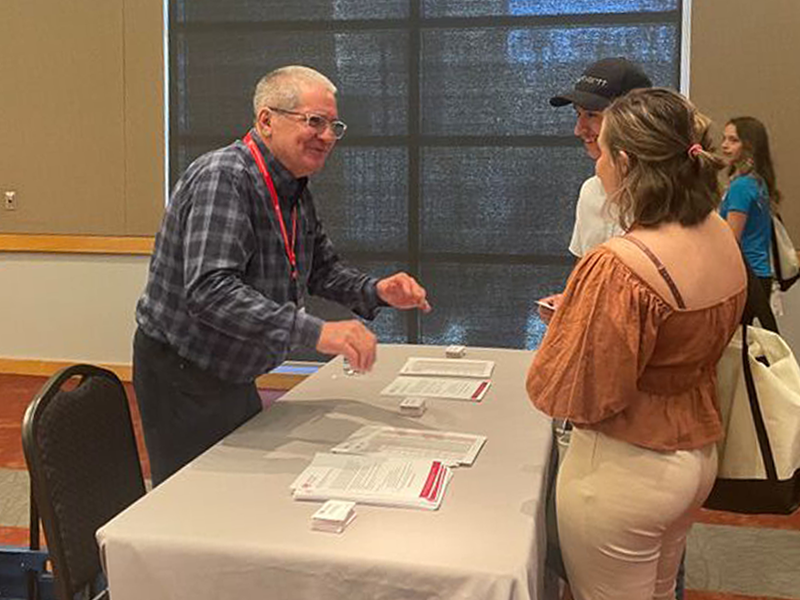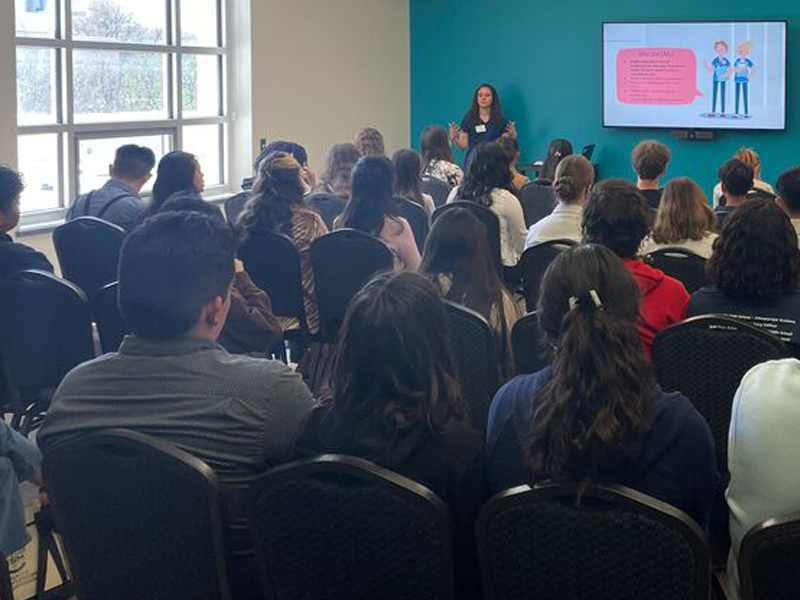In the spring of 2024, aspiring health care professionals will once again gather in The University of New Mexico’s Student Union Building for the 8th annual UNM Health Professions Symposium. Designed for students at all stages of their journey – from high school to learning professionals – the event provides a centralized opportunity to explore one’s passions, discover various pathways into a chosen field, and learn about the realities and challenges of an education and career in health care.
The journey to finding that passion in health care can be complex with twists and turns as UNM Health Professions Symposium founder James McKinnell, MD, knows well. McKinnell’s own path to the UNM School of Medicine was the inspiration behind creating an event for those aspiring to a career in health care.
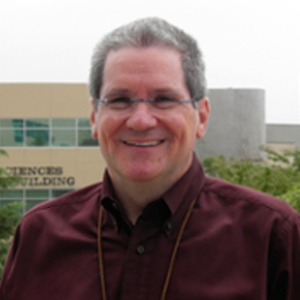
We want to help students overcome anything that might prevent them from taking advantage of this event, or from navigating the complex route to get into any of the health professions programs.
“The goal is to eliminate as many barriers as possible,” said McKinnell, MD, professor of pediatrics hematology oncology in the UNM School of Medicine. “We want to help students overcome anything that might prevent them from taking advantage of this event, or from navigating the complex route to get into any of the health professions programs. We try to bring as much information and as many different resources together on one day under one roof, and that makes the symposium an incredible resource in and of itself.”
The day-long symposium features 90 different workshops, with topics ranging from interview prep to modern pharmacy and indigenous health to biomedical sciences, just to name a few. Most importantly, the event is free and open to anyone pursuing or considering a career in health care.
McKinnell’s Career Journey
At first glance, McKinnell’s career path appears to be a traditional one: medical school at Ohio State, residency at St. Vincent’s Hospital in New York, and a pediatric oncology fellowship at NYU. But a closer look shows that the road to becoming a doctor was long and winding, with peaks and valleys along the way. After starting his education in political science and a six-month stint in graduate school for economics, McKinnell dropped out, left Colorado, and moved to New York.
“It was 1970,” said McKinnell, “so I moved to New York mainly because at that point I was trying to figure out what it meant to be gay and all those kinds of things. The first job I had was teaching swimming lessons to people who were afraid of water at a private health club in Manhattan. And I loved doing it. I was successful with of a lot of people, helping them overcome that fear of water and actually learn to swim.”
Despite that success, one couldn’t make a real living doing lifeguard work. After going through an employment agency that first tried to place him as an agent repossessing cars, McKinnell landed a job at a trade association crunching numbers all day. Even one of the vice presidents of that company could see it wasn’t a long-term solution for McKinnell. In fact, he took McKinnell out to lunch and told him so.
“His name was Scott, we were having sushi - it was very it was a memorable day,” said McKinnell. “Scott starts by telling me I’m doing a really good job, ‘but I think you need to find a new job.’ Which, of course, I thought meant he was firing me. But instead, he said, ‘there is no position in this company that you will find satisfying. It's not ever going to make you happy. So, you need to figure out what that work is and then go do it.’”
Inspired by this surprising turn of events, McKinnell thought about his swimming students – how much he loved helping them and how he was good at it. Fueled by these reflections, McKinnell moved back to Ohio, took the necessary pre-requisites, and applied to medical school. He didn’t get in. So, he took more courses, got a job in a hospital, and applied again. This time he got in.
“When I was accepted into medical school, I was 28 years old, and in 1981 that was a huge deal! Non-traditional students didn't exist,” McKinnell said.
Getting into medical school was only the first step. There were plenty of uphill roads left to navigate on McKinnell’s journey. He had an incredibly difficult first year of medical school and had to repeat the academic year after not passing a critical exam. During his internship, McKinnell shifted gears from rehabilitation to pediatrics and had to start over with an entirely new internship to secure a pediatric residency. By way of even more extenuating circumstances, McKinnell finally landed at NYU with a fellowship in pediatric hematology and oncology.
Upon completing the fellowship, McKinnell was invited to work in a pediatric oncology program at the Brooklyn Hospital Center. For 10 years, McKinnell helped to take care of about 500 kids with sickle cell disease. Such high patient volumes in the small, private hospital meant the providers were constantly in a situation of too much work to do without enough resources. The burnout started to set in, and McKinnell struggled to meet the endless demands.
Coming to UNM
Fate intervened in the form of a letter. It was a national mailing that arrived at their office, detailing a position at UNM’s pediatric oncology group. It was McKinnell’s colleague who opened that letter and said, “oh, there's a position in Albuquerque.” A native of India, she liked to say unfamiliar words out loud, and McKinnell suspects all those Qs looked like a fun challenge, because once she’d said the word, his colleague threw the letter in the garbage.
McKinnell grew up in Colorado, and while he’d never been to Albuquerque, he had been to Santa Fe. He fished the letter out of the trash, made some phone calls, had some important conversations, and soon enough he and his partner found themselves packing up their New York apartment in September of 2001. And McKinnell found himself taking yet another circuitous route.
“We were in New York on 9/11. I was on a subway that travelled under the World Trade Center that morning on my way to work. I got out of the subway in Brooklyn and looked up in the sky and there was a black plume of smoke over my head and sirens like I've never heard before,” McKinnell said. “We left New York about a week later. We were supposed to fly but decided we didn't feel comfortable flying out of LaGuardia Airport, where there were national guardsmen with machine guns. So, we did a road trip and drove down to New Mexico.”
After 10 years of a two-person practice in Brooklyn, coming on as the seventh member of the team in New Mexico fundamentally changed McKinnell’s life. Not only by creating more breathing room in his clinical practice with patients, but also by providing him with more time and opportunities to teach. It was through one of these opportunities that McKinnell started to bridge the divide between UNM’s central campus and the health sciences offerings on north campus.
Creation of UNM Health Professions Symposium
Through the University College, there was a unit called the Learning Communities program, which solicited seminar ideas from faculty. Having traveled such an indirect route into medicine himself, McKinnell pitched a class to help students understand how to access a career in health care. As the focus was initially on medical school, the seminar was called “So You Want to be a Doctor?” It would eventually become the course it is today: “So You Want to Work in Health Care?” A combination of academic advisement, career exploration, and building relationships with working professionals, the seminar was the small seed planted that would eventually grow into the Health Professions Symposium.
“My belief was always that at The University of New Mexico we want to go beyond recruiting the children of professionals into professional programs,” said McKinnell. “We want to develop a health care force that really does reflect the population of our state. And back when I first started teaching, I realized there are a lot of kids who want careers in health care but just don’t know how to get from point-A to point-B.”
McKinnell said that one of the most gratifying parts of his work at UNM was working with students who might not otherwise find their way into a health professions program. After several years of teaching the seminar, he started to wonder about a kind of health careers fair, to reach more students on a larger scale. He quickly learned that faculty and staff need to pay to reserve event space in the student union building (SUB), and so shared his idea around campus to see about drumming up interest and therefore funding. Which turned out to be irrelevant, as a young woman in the pre-Med society informed McKinnell that student organizations can use the SUB for free. And so, the Health Professions Symposium Committee was born.
The initial committee was comprised of about 12 students. Now, eight years later, there are 40 students on the committee, with six different subcommittees working on various aspects of organizing the event. With almost a decade of symposiums completed, it’s become a kind of full circle event.
“A number of the students who’ve been on the committee over the years have gone on to their professional lives, and lots of them now are coming back to present at the symposium,” said McKinnell. “It helps them understand the value of their experiences as both students and professionals. They can think back about the information they needed as students, and what insights do they want to share now – it’s thrilling to see. It’s just really, really cool to witness their growth and evolution as health care professionals participating in the community they helped to build.”
Register Now!
Registration is open now for the 8th Annual Health Professions Symposium, to be held on April 13, 2024 in UNM’s Student Union Building.

